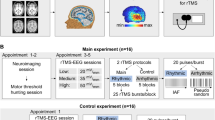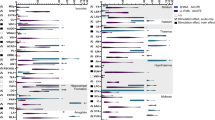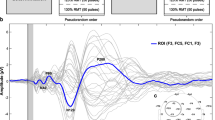Abstract
Repetitive transcranial magnetic stimulation (rTMS) has been shown to alter cortical excitability depending on the stimulus-frequency used, with high frequency (5 Hz and higher) increasing it but low frequency (usually 1 Hz or lower) reducing it. To determine the efficiency of different rTMS protocols in inducing cortical network activity, we tested the acute effect of one low-frequency rTMS protocol (1 Hz) and two different high-frequency protocols (10 Hz and intermittent theta-burst stimulation, iTBS) on the expression of the two immediate early gene (IEG) proteins c-Fos and zif268 in the rat brain. The cortical expression of both IEGs was specifically changed in an rTMS-dependent manner. One and 10 Hz rTMS enhanced c-Fos protein expression in all cortical areas tested, while iTBS was effective only in limbic cortices. Zif268 expression was increased in almost all cortical areas after iTBS, while 10 Hz rTMS was effective only in the primary motor and sensory cortices. One Hertz rTMS had no effect on cortical zif268 expression. Furthermore, sham-rTMS had no effect on zif268 expression but increased c-Fos in limbic cortices. This is the first study demonstrating that cortical zif268 and c-Fos expression can be specifically modulated by acute rTMS depending on the pattern of stimulation applied.





Similar content being viewed by others
References
Abraham WC, Demmer J, Richardson CL, Williams JM, Lawlor PA, Mason SE, Tate WP, Dragunow M (1993) Correlations between immediate early gene induction and the persistence of LTP. Neuroscience 56(3):717–727
Abraham WC, Christie BR, Logan B, Lawlor P, Dragunow M (1994) Immediate early gene expression associated with the persistence of heterosynaptic long-term depression in the hippocampus. Proc Natl Acad Sci USA 91(21):10049–10053
Aydin-Abidin S, Moliadze V, Eysel UT, Funke K (2006) Effects of repetitive TMS on visually evoked potentials and EEG in the anesthetized cat: dependence on stimulus-frequency and train duration. J Physiol Lond 574(2):443–455
Benali A, Leefken I, Eysel UT, Weiler E (2003) A computerized image analysis system for quantitative analysis of cells in histological brain sections. J Neurosci Methods 125(1–2):33–43
Ben-Shachar D, Belmaker RH, Grisaru N, Klein E (1997) Transcranial magnetic stimulation induces alterations in brain monoamines. J Neural Transm 104(2–3):191–197
Brasil-Neto JP, Cohen LG, Panizza M, Nilsson J, Roth BJ, Hallett M (1992) Optimal focal transcranial magnetic activation of the human motor cortex: effects of coil orientation, shape of the induced current pulse, and stimulus intensity. J Clin Neurophysiol 9(1):132–136
Chaudhuri A, Nissanov J, Larocque S, Rioux L (1997) Dual activity maps in primate visual cortex produced by different temporal patterns of zif268 mRNA and protein expression. Proc Natl Acad Sci USA 94(6):2671–2675
Chergui K, Nomikos GG, Mathe JM, Gonon F, Svensson TH (1996) Burst stimulation of the medial forebrain bundle selectively increase Fos-like immunoreactivity in the limbic forebrain of the rat. Neuroscience 72(1):141–156
Cole AJ, Saffen DW, Baraban JM, Worley PF (1989) Rapid increase of an immediate early gene messenger RNA in hippocampal neurons by synaptic NMDA receptor activation. Nature 340(6233):474–476
Davis S, Bozon B, Laroche S (2003) How necessary is the activation of the immediate early gene zif268 in synaptic plasticity and learning? Behav Brain Res 142(1–2):17–30
Doi W, Sato D, Fukuzako H, Takigawa M (2001) c-Fos expression in rat brain after repetitive transcranial magnetic stimulation. Neuroreport 12(6):1307–1310
Erhardt A, Sillaber I, Welt T, Müller MB, Singewald N, Keck ME (2004) Repetitive transcranial magnetic stimulation increases the release of dopamine in the nucleus accumbens shell of morphine-sensitized rats during abstinence. Neuropsychopharmacology 29(11):2074–2080
Esser SK, Huber R, Massimini M, Peterson MJ, Ferrarelli F, Tononi G (2006) A direct demonstration of cortical LTP in humans: a combined TMS/EEG study. Brain Res Bull 69(1): 86–94
Feige B, Scheffler K, Esposito F, Di Salle F, Hennig J, Seifritz E (2005) Cortical and subcortical correlates of electroencephalographic alpha rhythm modulation. J Neurophysiol 93(5):2864–2872
Fitzgerald PB, Fountain S, Daskalakis ZJ (2006) A comprehensive review of the effects of rTMS on motor cortical excitability and inhibition. Clin Neurophysiol 117(12):2584–2596
Funke K, Trippe J, Benali A (2006) High-frequency (theta) repetitive transcranial magnetic stimulation induces an increase of the metabolic activity but a decrease in parvalbumin cells in rat visual cortex. FENS Abstract, vol 3, A179.7
Gass P, Herdegen T, Bravo R, Kiessling M (1993) Induction and suppression of immediate early genes in specific rat brain regions by the non-competitive N-methyl-d-aspartate receptor antagonist MK-801. Neuroscience 53(3):749–758
George MS, Nahas Z, Kozel FA, Li X, Denslow S, Yamanaka K, Mishory A, Foust MJ, Bohning DE (2002) Mechanisms and state of the art of transcranial magnetic stimulation. J ECT 18(4):170–181
Gerfen CR, Keefe KA, Gauda EB (1995) D1 and D2 dopamine receptor function in the striatum: coactivation of D1- and D2-dopamine receptors on separate populations of neurons results in potentiated immediate early gene response in D1-containing neurons. J Neurosci 15(12):8167–8176
Guzowski JF, Setlow B, Wagner EK, McGaugh JL (2001) Experience-dependent gene expression in the rat hippocampus after spatial learning: a comparison of the immediate early genes Arc, c-Fos, and zif268. J Neurosci 21:5089–5098
Hausmann A, Weis C, Marksteiner J, Hinterhuber H, Humpel C (2000) Chronic repetitive transcranial magnetic stimulation enhances c-Fos in the parietal cortex and hippocampus. Brain Res Mol Brain Res 76(2):355–362
Herdegen T, Leah JD (1998) Inducible and constitutive transcription factors in the mammalian nervous system: control of gene expression by Jun, Fos and Krox and CREB/ATF proteins. Brain Res Rev 28(3):370–490
Huang YZ, Edwards MJ, Rounis E, Bhatia KP, Rothwell JC (2005) Theta burst stimulation of the human motor cortex. Neuron 45(2):201–206
Huang YZ, Chen RS, Rothwell JC, Wen HY (2007) The after-effect of human theta burst stimulation is NMDA receptor dependent. Clin Neurophysiol 118(5):1028–1032
Hughes SW, Crunelli V (2005) Thalamic mechanisms of EEG alpha rhythms and their pathological implications. Neuroscientist 11(4):357–372
Hyman SE, Cole RL, Konradi C, Kosofsky BE (1995) Dopamine regulation of transcription factor–target interactions in rat striatum. Chem Senses 20(2):257–260
Ji RR, Schlapfer TE, Aizenman CD, Epstein CM, Qiu D, Huang JC, Rupp F (1998) Repetitive transcranial magnetic stimulation activates specific regions in rat brain. Proc Natl Acad Sci USA 95(26):15635–15640
Jones MW, Errington ML, French PJ, Fine A, Bliss TV, Garel S, Charnay P, Bozon B, Laroche S, Davis S (2001) A requirement for the immediate early gene Zif268 in the expression of late LTP and long-term memories. Nat Neurosci 4(3):289–296
Kanno M, Matsumoto M, Togashi H, Yoshioka M, Mano Y (2004) Effects of acute repetitive transcranial magnetic stimulation on dopamine release in the rat dorsolateral striatum. J Neurol Sci 217(1):73–81
Keck ME, Welt T, Post A, Muller MB, Toschi N, Wigger A, Landgraf R, Holsboer F, Engelmann M (2001) Neuroendocrine and behavioral effects of repetitive transcranial magnetic stimulation in a psychopathological animal model are suggestive of antidepressant-like effects. Neuropsychopharmacology 24(4):337–349
Keck ME, Welt T, Muller MB, Erhardt A, Ohl F, Toschi N (2002) Repetitive transcranial magnetic stimulation increases the release of dopamine in the mesolimbic mesostriatal system. Neuropharmacology 43(1):101–109
Kim EJ, Kim WR, Chi SE, Lee KH, Park EH, Chae JH, Park SK, Kim HT, Choi JS (2006) Repetitive transcranial magnetic stimulation protects hippocampal plasticity in an animal model of depression. Neurosci Lett 405(1–2):79–83
Kubik S, Miyashita T, Guzowski JF (2007) Using immediate-early genes to map hippocampal subregional functions. Learn Mem 14(11):758–770
Lanahan A, Worley P (1998) Immediate-early genes and synaptic function. Neurobiol Learn Mem 70(1–2):37–43
Maccabee J, Amassian VE, Eberle L, Cracco RQ (1993) Magnetic coil stimulation of straight and bent amphibian and mammalian peripheral nerve in vitro: locus of excitation. J Physiol Lond 460(1):201–219
Michaluk J, Antkiewicz-Michaluk L, Vetulani J (2001) Conditions of application of repeated transcranial magnetic stimulation to rats may mask the effects of the treatment. Pol J Pharmacol 53(6):685–687
Mokin M, Keifer J (2005) Expression of the immediate-early gene-encoded protein Egr-1 (zif268) during in vitro classical conditioning. Learn Mem 12:144–149
Okuno H, Miyashita Y (1996) Expression of the transcription factor Zif268 in the temporal cortex of monkeys during visual paired associate learning. Eur J Neurosci 8(10):2118–2128
Paxinos G, Watson C (1986) The rat brain in stereotaxic coordinates. Academic, San Diego
Ribeiro S, Mello CV, Velho T, Gardner TJ, Jarvis ED, Pavlides C (2002) Induction of hippocampal long-term potentiation during waking leads to increased extrahippocampal zif-268 expression during ensuring rapid-eye-movement sleep. J Neurosci 22(24):10914–10923
Richardson CL, Tate WP, Mason SE, Lawlor PA, Dragunow M, Abraham WC (1992) Correlation between the induction of an immediate early gene, zif268, and long-term potentiation in the dentate gyrus. Brain Res 580(1–2):147–154
Robertson HA, Paul ML, Moratalla R, Graybiel AM (1991) Expression of the immediate early gene c-Fos in the basal ganglia: induction by dopaminergic drugs. Can J Neurol Sci 18(3):380–338
Shirvalkar P, Seth M, Schiff ND, Herrera DG (2006) Cognitive enhancement with central thalamic electrical stimulation. Proc Natl Acad Sci USA 103(45):17007–17012
Siebner HR, Rothwell J (2003) Transcranial magnetic stimulation: new insights into representational cortical plasticity. Exp Brain Res 148(1):1–16
Slattery DA, Morrow JA, Hudson AL, Hill DR, Nuitt DJ, Henry B (2005) Comparison of alterations in c-Fos and egr-1 (zif268) expression throughout the rat brain following the acute administration of different classes of antidepressant compounds. Neuropsychopharmacology 30(7):1278–1287
Strafella AP, Paus T, Barrett J, Dagher A (2001) Repetitive transcranial magnetic stimulation of the human prefrontal cortex induces dopamine release in the caudate nucleus. J Neurosci 21(15):1–4
Strafella AP, Paus T, Fraraccio M, Dagher A (2003) Striatal dopamine release induced by repetitive transcranial magnetic stimulation of the human motor cortex. Brain 126(12):2609–2615
Sun JJ, Kung JC, Wang CC, Chen SL, Shyu BC (2006) Short-term facilitation in the anterior cingulate cortex following stimulation of the medial thalamus in the rat. Brain Res 1097(1):101–115
Thickbroom GW, Byrnes ML, Edwards DJ, Mastaglia FL (2006) Repetitive paired-pulse TMS at I-wave periodicity markedly increases corticospinal excitability: a new technique for modulating synaptic plasticity. Clin Neurophysiol 117(1):61–66
Touge T, Gerschlager W, Brown P, Rothwell JC (2001) Are the after-effects of low-frequency rTMS on motor cortex excitability due to changes in the efficacy of cortical synapses. Clin Neurophysiol 112(11):2138–2145
Wang H, Wang X, Scheich H (1996) LTD and LTP induced by transcranial magnetic stimulation in auditory cortex. Neuroreport 7(2):521–525
Wang JQ (1998) Regulation of immediate early gene c-Fos and zif/268 mRNA expression in rat striatum by metabotropic glutamate receptor. Brain Res Mol Brain Res 57(1):46–53
Wisden W, Errington ML, Williams S, Dunnett SB, Waters C, Hitchcock D, Evan G, Bliss TVP, Hunt SP (1990) Differential expression of immediate early genes in the hippocampus and spinal cord. Neuron 4(4):603–614
Zangen A, Hyodo K (2002) Transcranial magnetic stimulation induces increases in extracellular levels of dopamine and glutamate in the nucleus accumbens. Neuroreport 13(18):2401–2405
Acknowledgments
We like to thank Ute Neubacher, Dimitrula Winkler, Gabi Bomholt and Angelika Herker-See for assisting in the immunocytochemical processing of the brain sections and Thomas Mittmann for his critical reading of the manuscript. This study had been supported by grants of the Deutsche Forschungsgemeinschaft (DFG, FU 256/2-1 to K.F., SFB 509 TP C12 to K.F., SFB 509 TP C4 to U.T.E.) and the Federal Ministry of Education and Science (BMBF, Competence Network “Stroke”, TP C1 to K.F. and U.T.E.).
Author information
Authors and Affiliations
Corresponding author
Additional information
Authors S. Aydin-Abidin and J. Trippe contributed equally to this work.
Rights and permissions
About this article
Cite this article
Aydin-Abidin, S., Trippe, J., Funke, K. et al. High- and low-frequency repetitive transcranial magnetic stimulation differentially activates c-Fos and zif268 protein expression in the rat brain. Exp Brain Res 188, 249–261 (2008). https://doi.org/10.1007/s00221-008-1356-2
Received:
Accepted:
Published:
Issue Date:
DOI: https://doi.org/10.1007/s00221-008-1356-2




